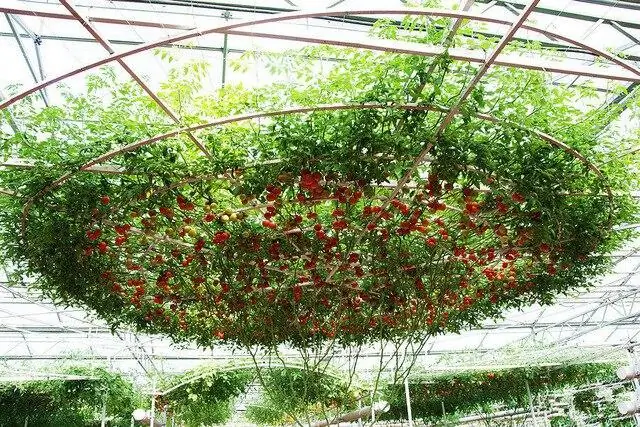
Table of contents:
- Tomarillo tomato tree: get to know - we are surprised - and grow
- What is tamarillo: description and features of the plant
- In what conditions to grow a tomato tree
- Planting a plant
- Taking care of tamarillo during growth
- Features of growing tamarillo in the open field
- Can you grow a tomato tree in a barrel?
- Reviews of Internet users about tamarillo and its cultivation
- Author Bailey Albertson [email protected].
- Public 2023-12-17 12:53.
- Last modified 2025-06-01 07:32.
Tomarillo tomato tree: get to know - we are surprised - and grow
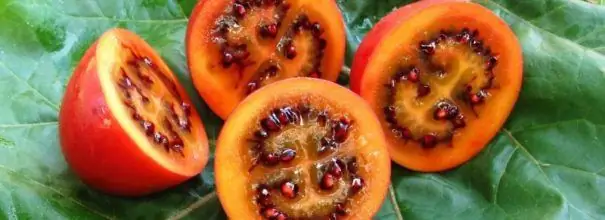
Exotic plants in our home are not uncommon for a long time, and for some time now we have been growing many of them even in summer cottages. We are talking not only about flowers, but also about vegetables, berries, and fruit trees. You may have already heard about a very interesting plant - tamarillo, or tomato tree. It not only looks beautiful, but also gives a high yield of tasty, juicy fruits. It turns out that tamarillo can be successfully grown in our latitudes, however, this will require attention, patience and strict adherence to the rules of agricultural technology.
Content
-
1 What is tamarillo: description and features of the plant
- 1.1 Video review of exotic tamarillo fruits
- 1.2 Tamarillo varieties
- 1.3 Video: what are the differences between tamarillo and what we mistakenly call a tomato tree
-
2 In what conditions to grow a tomato tree
- 2.1 Dimensions of the room for the greenhouse
- 2.2 Lighting and temperature control
- 2.3 Features of soil preparation
-
3 Planting a plant
- 3.1 Sowing seeds
- 3.2 How to care for seedlings
- 3.3 Planting seedlings
- 4 Caring for tamarillo during growth
- 5 Features of growing tamarillo in the open field
- 6 Can a tomato tree be grown in a barrel?
- 7 Reviews of Internet users about tamarillo and its cultivation
What is tamarillo: description and features of the plant
The tomato tree came to us from the vastness of South America. Since this continent has a warm climate, there this plant is considered an evergreen perennial and lives up to 10-15 years. In our latitudes, in open ground conditions, tamarillo grows only for 1 year. but long-term cultivation in a greenhouse is also possible with the maintenance of an appropriate temperature regime and room maintenance.
Tamarillo is also called octopus and tsifomandra. The plant belongs to the Solanaceae family; in the wild, it reaches a height of 5 meters. The diameter of the spreading crown can be 50 m². Oval wide leaves of rich green color are covered with small villi that prevent moisture evaporation. The leaf plates can reach a length of 35 cm. The stem of the plant is fragile and brittle, although it is covered with a tree-like bark. The root system is shallow, so the tree often grows aerial root shoots for stability.
The flowers of the tomato tree, depending on the variety, can be white, white-pink or light blue. Outwardly, they look like potato flowers. In the inflorescence there can be up to forty flowers, but more often there are 5-8 of them.
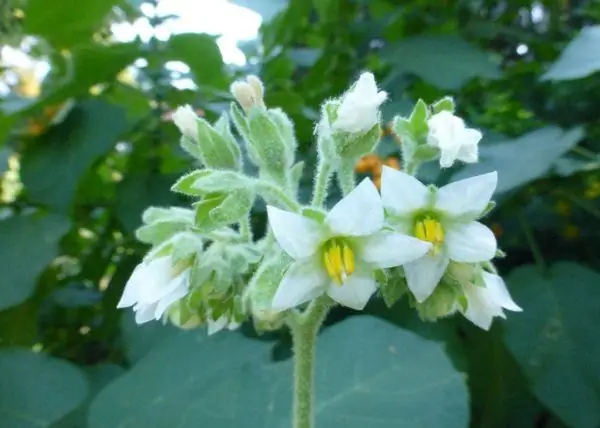
Tamarillo flowers are easy to confuse with potato flowers.
Tamarillo is a high-yielding plant. It begins to bear fruit in the second year after planting. The fruits are not very large, elongated, outwardly similar to tomatoes, but the taste is sweet, reminiscent of apricots and strawberries. For this reason, tamarillo is considered a fruit and not a vegetable. Each hand can have 5-6 fruits, 30 grams each. Their color can be orange or bright red. They are a two-chambered berry with firm pulp and dense skin.
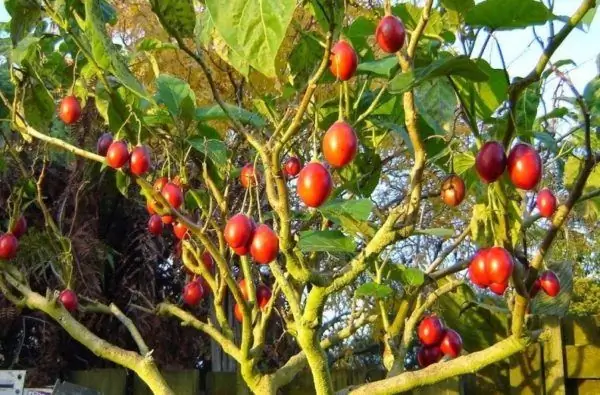
Tamarillo is a high-yielding crop with fruits that look like tomatoes
Video review of exotic tamarillo fruits
Tamarillo varieties
Now more than 30 varieties of the tomato tree are known. But it should be borne in mind that not all of them are suitable for us for growing, not only in the open field, but even in indoor conditions. In our latitudes, the following varieties are most popular:
-
Beetroot cyphomandra (Cyphomandra betacea) is an evergreen plant that is successfully grown in greenhouses and at home. This variety has long, oval leaves; fruits grow in dense bunches. They are similar to ordinary tomatoes not only in appearance, but also in taste.

Beet tsifomandra The fruits of the beetroot tsifomandra are similar to tomatoes both in appearance and in taste.
-
Cyphomandra tree-like (Cyphomandra abutiloides) grows in the form of a tree, the leaves look like an elongated heart. Small oval fruits can be yellow or orange. They taste sweet, so they are used for fruit salads, desserts and jams.

Tree-like cypher Arboreal tsifomandy Has sweet fruits, which are often used in the preparation of jams and desserts
-
Octopus F1 is one of the types of tree-like cypher. It is very popular in the Middle Lane, as it is adapted to the conditions of our climate. When grown in a greenhouse, one bush of this variety can produce about 10 kg of fruit in one season.

Tsifomandra Sprut F1 Tsifomandra variety Octopus F1 is known to many of our gardeners
By the way, judging by the information from the forums, many novice amateur gardeners are confused in terms. Tomato, or tomato tree, tamarillo, tsifomandra … As I noticed, many people call the tomato tree familiar to us tomatoes, grown in a special way, thanks to which they grow up to two or more meters in height. And their productivity increases significantly, which again makes them confuse with tamarillo, which is famous for its high fruiting. As for the name "Tsifomandra", it turns out that there is such a variety of tomatoes, also high-yielding, and also large-fruited. But it is not directly related to the plant considered in this article. Most likely, the confusion is due to the fact that all these crops belong to the order of the nightshade, because their names are associated with tomatoes (tomatoes). Still, be careful when choosing seeds, decide for yourselfwhat do you want: tomatoes or exotic tamarillo fruits. Because, despite the outward similarity, nevertheless, "as they say here in Odessa, these are two big differences."
Video: what are the differences between tamarillo and what we mistakenly call a tomato tree
In what conditions to grow a tomato tree
Since the tsifomandra is large, it needs space. She also needs warmth and sunlight. Therefore, in our climate, it is better to grow tamarillo in a greenhouse, observing special conditions.
Dimensions of the room for the greenhouse
Any type of greenhouse is suitable for growing a tomato tree. The main thing is to provide constant heating and regular lighting. If you plan to provide the plant with conditions close to natural, in which it will live for many years, please note: the area of the room should be at least 50 m² and a height of 4 m.
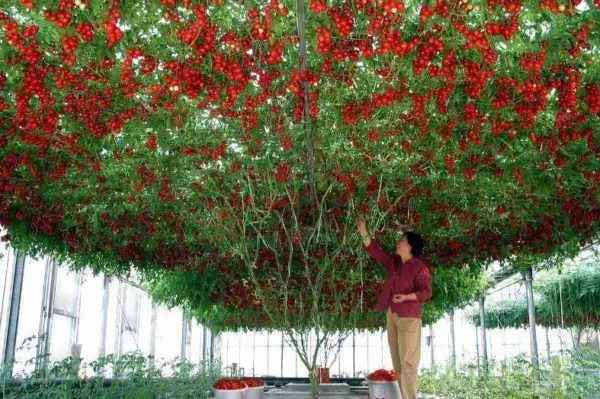
A tomato tree can grow huge, so a greenhouse for it must be appropriate.
In addition, you will need a large capacity to house the root system. For example, an old bathtub will work well. Also prepare a cover of suitable size: you will need it to protect the roots from moisture loss in the summer. Another small container should be nearby so that you can prepare nutrient solutions for feeding the tomato tree in it.
If you do not have a room of a suitable area, then you can grow tamarillo in a regular greenhouse. But in this case, you can only count on seasonal fruit production within 10 kg per plant, which will reach the size of a bush. For comparison, an adult tomato tree, grown in its natural environment to a huge size, gives up to 1500 kg of fruit.
Lighting and temperature control
The development and yield of tamarillo directly depends on the appropriate temperature and light conditions in the room, which must be provided from the moment the seeds are sown to the ripening of the fruits.
A tomato tree needs a day of light lasting at least 12 hours, so the greenhouse must be equipped with sources of additional lighting - fluorescent lamps.
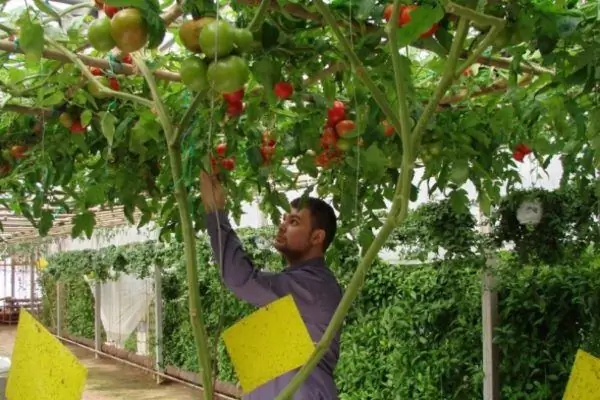
The tomato tree needs a lot of light and a warm climate
The optimum temperature for a plant in summer should be + 24 … + 25 ° C, in winter - not lower than +19 ° C. Therefore, heating is carried out in the greenhouse or heating devices are installed.
Features of soil preparation
For growing tamarillo, the soil is well suited, which is used for growing ordinary tomatoes. The main condition is lightness, breathability and high nutritional value. This applies to cultivation both in the greenhouse and in the open field.
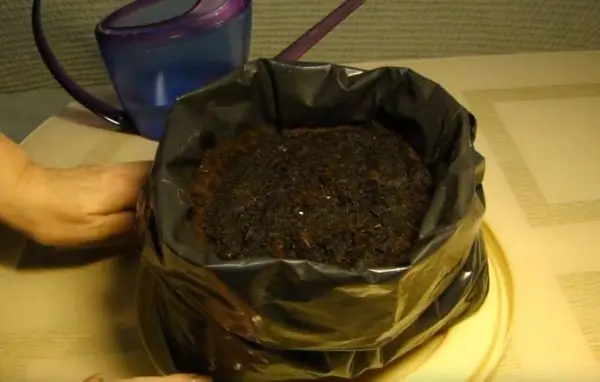
For tamarillo, a light nutritious soil with good breathability is suitable
Since the tomato tree is very nutritional, use liquid fertilizers designed for regular tomatoes to feed it, according to the instructions on the package. It is also allowed to use long-acting fertilizers in the form of granules and sticks.
After planting a tree, the soil around it must be mulched. For this, expanded clay is used. It can be replaced with sphagnum moss.
Planting a plant
Tsifomandra is grown in several stages:
- sowing seeds;
- seedling care;
- planting seedlings in a prepared place.
Let's consider each of them in more detail.
Sowing seeds
You can sow tamarillo seeds at any time of the year. But many experienced gardeners and gardeners recommend observing the seasonality and sowing at the end of winter or very early spring.
- The seeds must first be hardened. To do this, place them in the refrigerator and keep them there for 12 hours. After that, you can sow them in pre-prepared containers for seedlings. These can be wooden boxes or ceramic pots at least 15-20 cm high.
- Fill containers with soil, loosen well. Bury the seeds one by one to a depth of 1.5 cm, keeping a distance of 2-3 cm. Water and cover the container with plastic wrap to ensure the greenhouse effect.
-
Place the seed box on a well-lit windowsill. Open the airing film a little every day. When the soil dries up, water the plantings with a little water.

Tamarillo seedlings Provide good watering, warmth and aeration until the seeds sprout.
-
After the seeds have sprouted, plant them in separate small pots. Place them in a well-lit place. There they will grow until they reach the desired size and are transplanted to a permanent place.

Tamarillo seedling in a glass Plant the grown and strengthened seedlings in different containers
How to care for seedlings
Seedlings require proper watering and timely fertilization.
- Watering should be done as the soil dries up, 3-4 times a week. This is done exclusively through a pallet in which there are pots with holes in the bottom.
- Top dressing is carried out at least once every 3-4 months. For this, complex compositions are used for fertilizing tomatoes. Small, weak seedlings require more frequent feeding. Strictly follow the instructions on the packaging.
- If you are growing seedlings in winter, water no more than 1 time per week, and stop feeding.
Transplanting
Tamarillo seedlings will be ready to be planted in the greenhouse about 3 months after sowing. For example, if the seeds were planted in January-early February, then already in mid-April you will be able to plant seedlings in a permanent place.
- Make sure that the temperature in the greenhouse is + 20… + 25 ° C for several days before planting. This will be enough for the seedlings to start and start active growth.
-
It is recommended to raise the planting beds about 0.5 m above the soil level and line them with silicate bricks. Thanks to this, the soil in the beds will evenly warm up.

Tamarillo in the beds in the greenhouse Raise the beds half a meter and cover with brick or stone for thermal insulation
- Review your seedlings and choose the healthiest, strongest and most robust seedlings. It is them that need to be planted.
- Make holes in the ground 10-15 cm deep. Add a handful of ash and a little Azofoska to them. Ideally, the soil should be fertilized with compost beforehand, in the fall, laying it 20-25 cm deep.
- Break off the 2 lower rows of leaves from the seedling: this will provide the formation of additional root shoots. Place the seedling in the ground so that the remaining leaves are directly above the ground.
- Place arcs over the seedlings and cover them with foil until the temperature in the greenhouse stabilizes and the fluctuations between day and night are normalized.
Taking care of tamarillo during growth
The correct planting of seedlings in a greenhouse is only the beginning of growing a tomato tree. Now you need to follow cultivation techniques, which are extremely important for the health and productivity of the plant.
Apply organic fertilizers to the soil at least once a week. Mineral compositions containing:
- boric acid;
- simple superphosphate;
- ammonium nitrate;
- magnesium;
- calcium;
- zinc;
- copper.
It is better to buy ready-made fertilizers in specialized stores.

For feeding tamarillo, the same organic fertilizers are suitable as for tomatoes.
To prevent diseases, add iodine solution to the soil (1 bottle per 10 liters of water). It is also useful to feed tamarillo with a solution of herbal infusion once a week.
Since the tomato tree grows very large, it needs abundant watering. In hot sunny weather, it must be done daily. The soil under the tree must be constantly moist.
A fruit-bearing tree is best watered in the morning. The fact is that the skin of the fruit tends to expand in the morning and taper in the evening. If you water the plant twice a day, the moisture will tear the inside of the fruit and it will crack.
Due to the observance of agricultural technology and favorable conditions, the tree will give its first fruits in mid-June and will bear fruit until autumn.
Features of growing tamarillo in the open field
Even in our climate, the tomato tree can be grown in the garden, in an open area. It is better to use a hybrid plant of the Sprut variety for this. True, it will be annual, but nevertheless it will give you a good harvest.
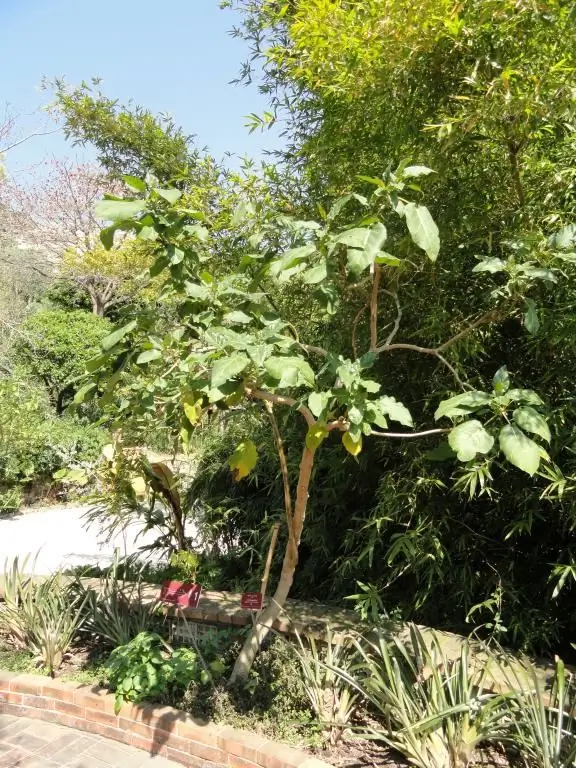
Tamarillo can be grown outdoors, but the plant will only grow for one year.
- Caring for a tree will not be difficult, it differs little from caring for ordinary tomatoes. But it is very important to follow certain rules.
- Seeds for seedlings for subsequent transplantation in open ground must be sown much earlier than for growing in a greenhouse. In winter, the seedlings must be provided with intense artificial lighting.
- It is necessary to plant seedlings when the soil warms up by at least 5-8 degrees. You need to choose a suitable area in the garden. A tomato tree of the Octopus variety needs good lighting.
- Pinch the main root before planting to stimulate the growth of new roots and the entire bush.
- Seedlings are grown according to the scheme 40 X 60 X 140 cm. This is due to the fact that an adult tree can reach 3-4 m in diameter.
- The size of the hole should correspond to the width of the root system. The depth of the hole is calculated individually for each bush, adding 10-15 cm to the length of the largest root.
- Tamarillo planted in open ground does not need pinching, as is the case with planting in a greenhouse.
- Feed regularly in the same way as for greenhouse cultivation. Spread large quantities of compost directly at the root.
- Follow the rules of prevention and control of diseases and pests. In the case of the Octopus variety, they are no different from the methods of protecting ordinary tomatoes.
- For a large harvest, pick off old and yellow leaves from the bottom of the trunk. This should be started from the moment the fruit ripens from the first flower cluster. Such measures will provide good ventilation, due to which the plant is less sick. When the fruit begins to ripen on the second cluster, all leaves from the first must be removed.
Can you grow a tomato tree in a barrel?
If you live in a private house, you can grow tamarillo indoors, taking it out into the yard for the summer season, and bring it indoors for the winter. For this, any large container is suitable, for example, a large barrel. And you don't need to plant a tree in soil or a greenhouse.
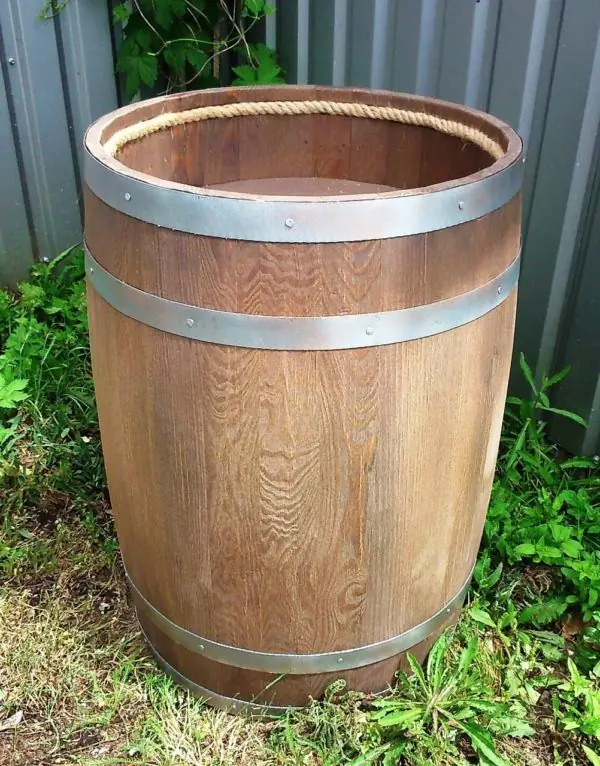
Wooden barrel is a great container for growing garden plants, including tamarillo
- It is advisable to cut the barrel into two parts across. The tamarillo root system does not need much depth, but it does take space.
- Place the barrel in a suitable place so that it is convenient to move it if necessary. The site should be lit, but sheltered from the winds. Tamarillo does not tolerate cold and drafts.
- Fill the barrel almost to the top with a nutritious soil mixture. Purchased potting soil works well with a small amount of manure or compost.
- Make a hole in the soil so deep that the roots of the seedling fit freely in it. Place the seedling in the hole, sprinkle with earth, press the soil a little. Place mulch around the plant. Do not mulch the soil very much in the immediate vicinity of the trunk, as this can cause rotting.
- Water the seedling thoroughly. Watering should be done regularly and abundantly, especially in dry, hot weather. Also, do not forget about liquid feeding at least once a month.
- The tree must be tied to a stick so that it does not tilt, especially during the ripening of the fruit.
-
When the plant reaches a height of 1 meter, cut off its top by 10-15 cm. So the tamarillo will not grow up, but in breadth.

Ceramic flowerpots If you don't have a suitable barrel at hand, plant the tamarillo in a beautiful ceramic flowerpot.
I will tell you my story of growing tamarillo. I didn’t even know that this fruit was called that when I was treated to it a year ago, warning that he needed to lie down and ripen for a couple of weeks. The friend who gave it as a present simply forgot the real name, only said that it was like a tomato, but not a tomato at all. As a result, I found it on the Internet, read about an exotic miracle fruit and decided: why not try to grow it? There are seeds, there is a suitable pot, and I just bought soil for seedlings. Moreover, the taste seemed very interesting. The seeds sprouted pretty quickly, it seems, after 2 weeks. She transplanted the largest seedlings by diving. Already in August, the trees reached a height of 40 cm and had several large full-fledged leaves. My joy knew no bounds, but then the unpleasant began. Although the tamarillo pots were in different places,insects were found on each plant. Simple manipulations in Google helped to find out that these are whiteflies. Tellingly, the other flowers were healthy, so where this attack came from, it remained unclear. There were no insect repellents in the house. And besides, I read that tamarillo is almost not susceptible to diseases or pests, so I did not expect a catch. I tried to treat with a pediculosis remedy and an insecticide for cats - it did not help. I decided to go to extreme measures, bought the drug Aktara and spilled the plants with it 3 times with an interval of 7 days. The whiteflies are gone, but the leaves have fallen as well. The plants almost died, but over time, buds appeared on the remaining stumps, and then new leaves. In general, in a couple of months my tamarillos returned to their previous appearance. This year, I think it will be possible to wait for the harvest, because we are already blooming!
Reviews of Internet users about tamarillo and its cultivation
The road will be mastered by the one walking, as folk wisdom says. This means that we are quite capable of growing even such a capricious, demanding tree as tamarillo. The main thing is to start, especially since it is such an exciting activity, and the joy of a rich harvest always overrides any chores. We hope that our tips will help you get it right if you want to start a tomato tree in your home, garden or greenhouse. Or maybe you are already growing tamarillo? Then share your experience with us in the comments. Good luck and good harvests!
Recommended:
Apple-tree Melba: Description And Characteristics Of The Variety, Advantages And Disadvantages, Planting And Care Features + Photos And Reviews
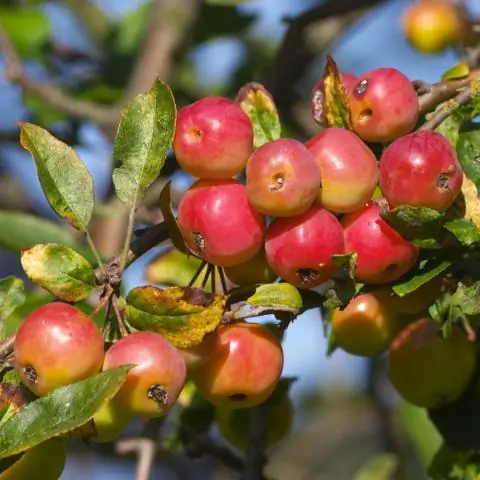
The Melba apple tree has been popular all over the world for almost a hundred years. And success is not only due to the taste of the fruit. How to care for a tree to get a consistent harvest?
Zamioculcas: All The Nuances Of Caring For A Dollar Tree At Home + Photos And Videos

Zamioculcas is a plant that no bank can do without. What is the reason for this? How to grow a flower at home? Planting and grooming secrets
How To Grow Plumeria From Seeds At Home: Step-by-step Instructions With Photos And Videos, Further Care Of The Plant

Growing plumeria seeds at home. Germination and planting tips. Required care: watering, fertilizing, etc. Pests and the fight against them
Ehmeya: All The Nuances Of Caring For A Flower At Home (striped And Other Varieties) + Photos And Videos

Description of ehmeya and features of her care. Planting and transplanting at home. Errors, diseases and pests - how to deal with them. Florist reviews
Basil Cultivation And Care, Including In Ukraine, The Moscow Region And In Other Regions, As Well As A Description Of Varieties With Characteristics And Reviews
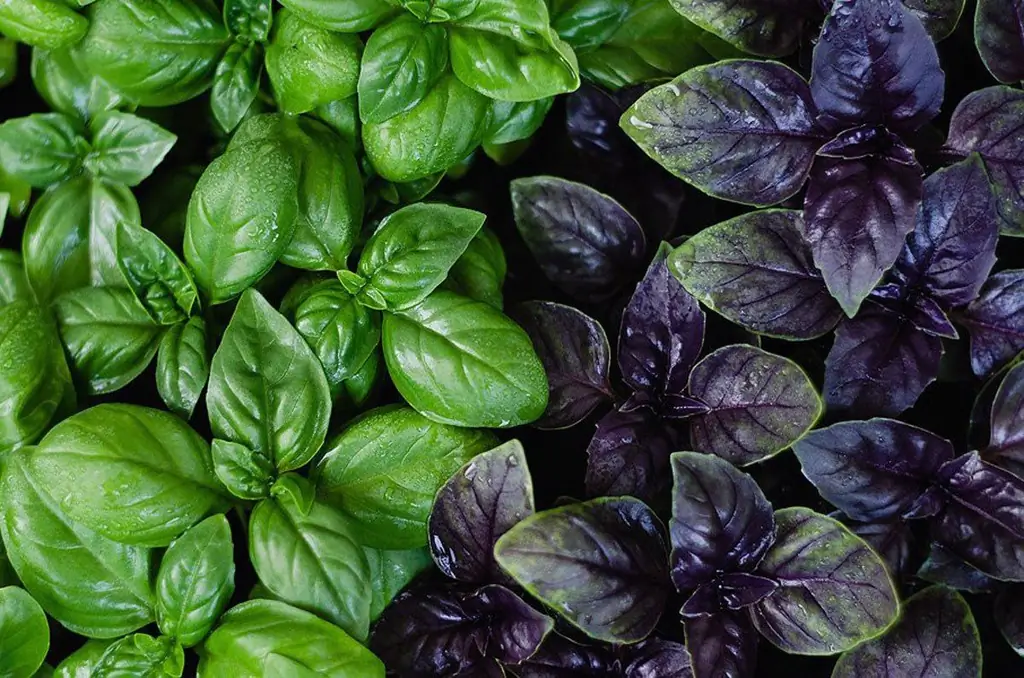
What is basil? How to plant and care for basil: reproduction, watering, feeding. Diseases and pests of basil: signs and methods of control
